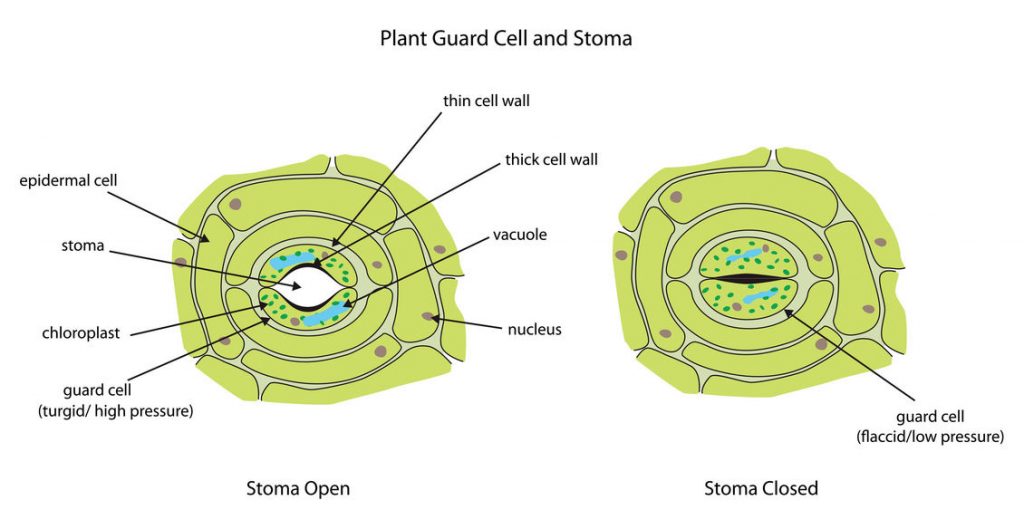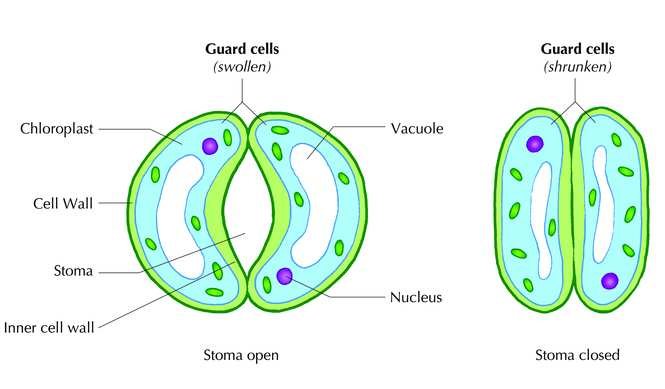Stomata are small pores on the underside of leaves that allow the exchange of gases necessary for Photosynthesis.
Guard cells are two curved cells surrounding each stomatal pore, regulate the opening and closing of the stomata.
Table of Contents
The role of Guard cells in Regulating the opening and closing of the stomata
Stomata Closing
When conditions for photosynthesis are poor, for example during the night or when water levels are low, water passes out of the guard cells, causing them to become flaccid and the stomata to close. This helps to prevent the plant from losing water.
Stomata Opening
During the day, when there is enough light and water, the guard cells absorb water by osmosis, become turgid and causing the stomata to open.

2 Important Theories to explain the Opening and Closing of The Stomatal Pore by the Guard Cell
There are two theories that explain how the guard cells regulate the opening and closing of the stomatal pores:
- The Potassium ion Concentration Theory
- The Sugar Concentration Theory
The Potassium ion Concentration Theory
- According to the potassium ion concentration theory, the opening and closing of stomata depend on the generation of a potassium ion gradient (K+).
- During the day, the chloroplasts in the guard cells carry out photosynthesis, which leads to the production of ATP.
- This ATP is used to actively pump potassium ions of the adjacent cells into the guard cells. The increased potassium ion concentration in the guard cells makes them hypertonic.
- This draws in more water from the neighbouring cells, causing the cells more turgid and causing them to move outwards to open the stomatal pore.
- At night, the opposite happens: the potassium ions escape, decreasing the turgor of the guard cells and closing the stomatal pore.
Also Check – What are Plant Hormones
The Sugar Concentration Theory
- According to the sugar concentration theory, during the day, the guard cells start photosynthesis during the day and the sugar (glucose) produced increases the osmotic pressure, which draws in water from the adjacent cells due to endosmosis.
- The guard cells become turgid and bulge outwards due to their thin outer wall, thus widening the stomatal opening lying in between them.
- When the stomata open, diffusion of gases inwards and outwards begins to meet the demand for photosynthesis and allow transpiration.
Guard cells play a crucial role in regulating the opening and closing of stomatal pores in plants. The two theories, potassium ion concentration theory and sugar concentration theory, explain how guard cells maintain the right balance of water and ions to control the opening and closing of stomata.
Frequently asked questions on Role of Guard cells in Regulating Opening and Closing of Stomatal Pores
What are stomata?
Answer – Stomata are small pores on the underside of leaves that facilitate the exchange of gases necessary for photosynthesis.
What role do guard cells play in regulating the opening and closing of stomata?
Answer – The guard cells, which are two curved cells surrounding each stomatal pore, regulate the opening and closing of the stomata.
Also Check- Life Processes Class 10 MCQ
What happens when the stomata close?
Answer – When the conditions for photosynthesis are poor, e.g. during the night or when the water level is low, the water passes out of the guard cells causing them to become flaccid and the stomata to close. This prevents the plant from losing water.
What happens when the stomata open?
Answer – During the day, when there is enough light and water, the guard cells take up water by osmosis, become swollen and the stomata open.
Which two theories explain how the guard cells regulate the opening and closing of the stomata?
Answer – The two theories are the potassium ion concentration theory and the sugar concentration theory.
Explain the potassium ion concentration theory.
Answer – According to the potassium ion concentration theory, the opening and closing of the stomata depends on the generation of a potassium ion gradient. During the day, the ATP generated by photosynthesis is used to actively pump potassium ions from adjacent cells into the guard cells. This increases the potassium ion concentration in the guard cells, making them hypertonic and drawing in more water from the neighbouring cells, causing them to become turgid and move outwards to open the stomatal pore. At night the opposite happens, causing the potassium ions to escape, the turgor of the guard cells to decrease and the stomatal pore to close.
Explain the sugar concentration theory.
Answer – According to the sugar concentration theory, during the day, the guard cells begin photosynthesis and the sugar (glucose) produced increases the osmotic pressure, which draws in water from the neighbouring cells by endosmosis. The guard cells become turgid and bulge outwards, causing the stomata between them to widen. When the stomata open, diffusion of gases inwards and outwards begins to meet the needs of photosynthesis and allow transpiration.


8 Comments on “How do the Guard cells Regulate Opening and Closing of Stomatal Pores”